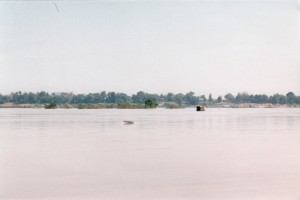[In January 2003 I accompanied an expedition that was conducting a survey of river dolphins on a stretch of the Mekong River in Cambodia. The expedition was led by Isabel Beasley, who was then a PhD student specializing on Orcaella brevirostris: also known as the ‘Irrawaddy Dolphin’ this species is found in many Asian river systems and deltas. The journal I kept during the expedition will appear on this site as a continuous series of posts. This is part 19 of the series.]
January 9, 2003
We’re setting out in two boats this morning. This is the beginning of the expedition properly speaking. Now we head straight up to the Laos border and won’t return to Kratie till the middle of next week.
From Kratie to Sombok we will take taxis – the boats have trouble on this stretch of the river because of the rapids. Although they can negotiate the rapids it is slow going and takes 3 hours or so. By taxi it takes only an hour.
At Sombok by arrangement there are boats waiting. The boatman is a Mr. San, a tall man, with very high cheekbones; he looks distinctly Vietnamese. Yesterday Mr. San drove the boat that Isabel and I were in, along with two other, one Mr. Seng Kim and another man. Mr. San’s brother drove a second boat, with an accompanying party.
We spotted dolphins very soon after we left Sombok – apparently there is a spot near the village that is frequently visited by dolphins at this time of year. It isn’t a recognized pool as such, but rather a place that they migrate to at certain times. In fact, I was the one who made the first sighting: I was initially hesitant to alert Isabel – who was on binocular watch – because I thought it might be against the protocol. But Isabel said the we were on ‘direct observation’ at that time and anyone could make the call, as and when a dolphin is spotted.
We saw about three dolphins at that spot and then moved on – or rather back – because the idea was to pick up the survey exactly where the course (as charted by the GPS) had been interrupted the day before.
This is possible because the map from the day before can be called up on the GPS device and the current position of the boat can be mapped on it. You can actually watch yourself moving on the little screen as you intercept the course.


